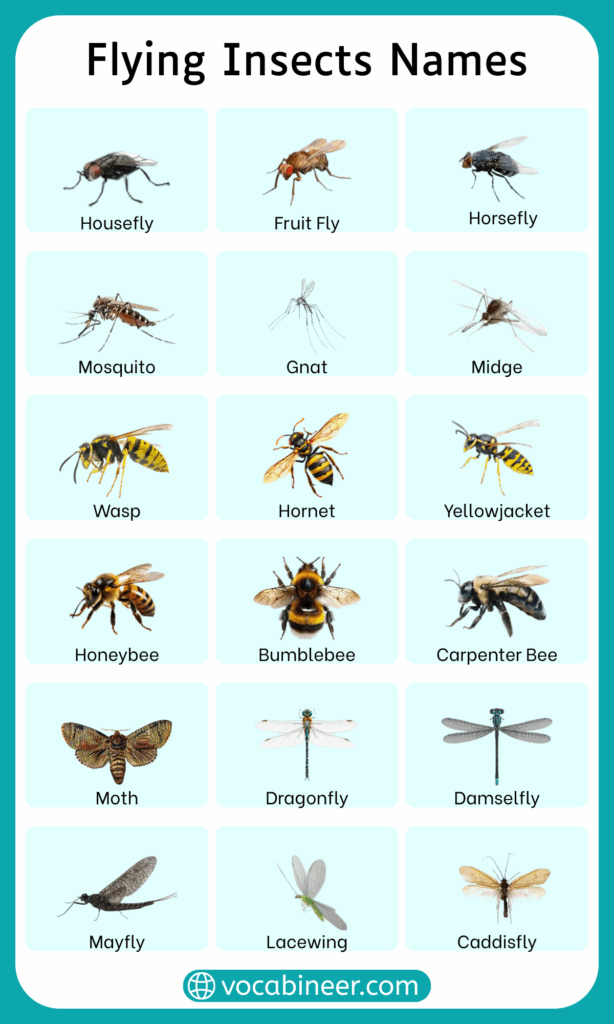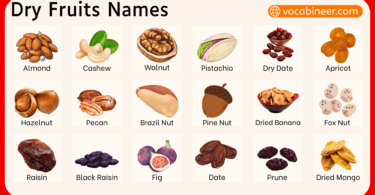Flying insects are one of the largest groups of animals on Earth. They move through the air using wings of different sizes and shapes. Some are very small and fragile, while others are strong hunters with sharp eyes. This article teaches flying insects names with their pictures so you can recognize them in everyday conversations, school lessons, and outdoor learning.
In This Page
List of Common Flying Insects Names
Flying insects are common in daily life and easy to notice. Some feed on flowers, some bite, and others glow. Here is a list of 20 common flying insects with names and descriptions to help you identify them.
- Housefly: A very common insect found near food and waste, spreading germs as it lands on surfaces and breeds quickly.
- Mosquito: Thin-bodied insect that bites humans and animals to drink blood, sometimes spreading diseases like malaria and dengue fever.
- Bee: Pollinating insect that makes honey and wax, lives in hives, and helps plants grow by carrying pollen.
- Wasp: Slim insect with a painful sting, often nesting in trees or buildings, also hunting smaller insects for food.
- Hornet: Large wasp species with a strong sting, known for defending their nests fiercely when disturbed.
- Butterfly: Colorful insect with scaled wings, often flying from flower to flower to feed on nectar.
- Moth: Insect similar to butterflies, usually active at night and often drawn to light sources.
- Dragonfly: Fast-flying insect with long wings and sharp eyesight, often hunting mosquitoes and other small insects near water.
- Damselfly: Slender insect related to dragonflies, usually resting with its wings closed along its body.
- Grasshopper: Jumping insect that also uses wings to fly short distances, feeding mostly on grass and leaves.
- Locust: A type of grasshopper that forms swarms, flying long distances and damaging crops during outbreaks.
- Cicada: Large insect known for loud summer calls, able to fly short distances after years spent underground.
- Ladybug: Small red beetle with black spots, known for flying and eating plant pests like aphids.
- Firefly: Beetle that produces natural light at night to attract mates, often seen glowing in summer fields.
- Japanese beetle: Shiny green beetle that flies in groups, damaging leaves and flowers by chewing holes.
- June beetle: Brown beetle active during summer nights, often attracted to lights around homes and gardens.
- Horsefly: Large biting fly that feeds on animal blood, known for its painful bites and fast flight.
- Deer fly: Smaller than horseflies, but also bite humans and animals, often found near water or wetlands.
- Mayfly: Fragile insect with very short adult life, flying only a day or two before dying.
- Caddisfly: Insect with hairy wings, found near water, whose young build protective cases out of sand and plants.

Pollinator Insects
Pollinator insects carry pollen between flowers, helping plants make seeds and grow.
- Honeybee: Social insects that live in hives, make honey, and pollinate many plants.
- Bumblebee: Large, fuzzy bees that make a loud buzzing sound while flying.
- Carpenter bee: Bees that make nests in wood by chewing small holes.
- Wasp: Slim-bodied insects that sting and also control other pests.
- Hornet: A type of large wasp with a powerful sting.
- Yellowjacket: Aggressive wasps often seen near food or garbage.
- Sweat bee: Small metallic-colored bees that are drawn to human sweat.
- Leafcutter bee: Bees that cut small pieces of leaves to build nests.
Butterflies and Moths
Butterflies and moths are colorful insects with wings covered in tiny scales. Many are admired for their patterns and bright colors.
- Monarch butterfly: Orange and black butterfly famous for long migrations.
- Swallowtail butterfly: Large butterfly with colorful wings and long tails.
- Painted lady: Butterfly with orange and black patterns found around the world.
- Blue morpho: Tropical butterfly with bright blue wings.
- Cabbage white: Small white butterfly common in gardens.
- Admiral butterfly: Dark butterfly with red and white wing bands.
- Skipper: Small butterflies that fly quickly with jerky movements.
- Tiger butterfly: Butterfly with yellow and black stripes like a tiger.
- Luna moth: Large moth with pale green wings and long tails.
- Atlas moth: Giant moth with wide patterned wings.
- Polyphemus moth: Moth with large eyespots on its wings.
- Hawk moth: Fast-flying moth with a long tongue for drinking nectar.
- Tiger moth: Brightly patterned moths with colors that warn predators.
- Silkworm moth: Moth raised by people for making silk.
Dragonflies and Damselflies
Dragonflies and damselflies are fast-flying insects with long bodies and large eyes. They live near ponds, lakes, and rivers because their young grow in water.
- Red dragonfly: Bright red insect often seen flying over wetlands and resting on plants.
- Blue dasher: Small dragonfly with blue coloring and striped body, usually found around ponds.
- Ebony jewelwing: Metallic green damselfly with shiny black wings, easy to spot near streams.
- Green darner: Large dragonfly that migrates long distances, often seen in groups.
- Four-spotted chaser: Dragonfly with four black wing spots, strong flyer in open areas.
- Broad-winged damselfly: Damselfly with wide, colorful wings, usually resting on plants near water.
Beetles that Can Fly
Beetles may look heavy, but many of them use hidden wings to fly. Here are some well-known flying beetles:
- Ladybug: Small red beetle with black spots, helpful in gardens because it eats plant pests like aphids.
- Firefly: Beetle that glows at night using light organs on its abdomen to attract mates.
- Scarab beetle: Strong beetle often shiny, known for rolling dung balls and being important in ancient cultures.
- Click beetle: Slim beetle that makes a clicking sound when flipping itself upright from its back.
- Soldier beetle: Bright-colored beetle often seen on flowers, feeding on nectar and smaller insects.
- Japanese beetle: Metallic green beetle that damages leaves, flowers, and crops by chewing holes.
- June beetle: Brown beetle active on warm summer nights, often attracted to lights.
Seasonal Flying Insects
Some flying insects only appear during certain times of the year. Their life cycles match the seasons, which makes them easier to notice.
- Cicada: Insects that emerge in summer, known for their loud, buzzing calls from trees.
- Mayfly: Fragile insects seen in spring and early summer, with adults living for only a day or two.
- Grasshopper: Found mostly in warm months, strong jumpers that also fly short distances with wings.
- Locust: A type of grasshopper that gathers in huge swarms, flying long distances and damaging crops.
- Mole cricket: Burrowing insects that sing at night and can also fly during certain warm seasons.
Biting and Stinging Flyers
These insects bite or sting as a way to feed or protect themselves.
- Horsefly: Large fly with painful bites.
- Deer fly: Smaller fly with sharp biting parts.
- Sandfly: Small fly that can spread diseases.
- Botfly: Fly that lays larvae on animals.
- Tsetse fly: African fly known for spreading sleeping sickness.
Insects with “Fly” in Their Name
Some insects have “fly” in their names, but not all are true flies.
- Fruit fly: Tiny fly used in science research.
- Mayfly: Delicate insect with a very short adult life.
- Whitefly: Small insect that damages plants by sucking sap.
- Dobsonfly: Large insect with long jaws.
- Caddisfly: Insect whose young build cases in water.
- Alderfly: Dark insect found near rivers.
- Stonefly: Insect with folded wings often found near streams.
Insects That Cannot Fly
Some insects never fly because they have no wings, or they only use them for short times.
- Ant: Most ants cannot fly, but winged ants appear during mating.
- Termite: Only some adults have wings, others remain wingless.
- Silverfish: Small silver insects without wings.
- Flea: Jumping insects that do not have wings.
- Louse: Parasites that live on people or animals without wings.
Interesting Facts About Flying Insects
Flying insects are full of surprising details. Here are some facts that make them stand out:
- Fastest flyer: Dragonflies can reach speeds of around 30–35 miles per hour.
- Longest wings: Atlas moths have some of the widest wings in the insect world.
- Light makers: Fireflies produce natural light through a process called bioluminescence.
- Color warning: Yellow and black stripes on bees and wasps warn predators to stay away.
FAQs About Flying Insects
Moths, mosquitoes, and fireflies are most active after dark. Moths move toward light, mosquitoes feed on blood, and fireflies glow to find mates. Darkness helps these insects feed and survive safely.
Dragonflies are among the fastest flying insects, reaching speeds of 30–35 miles per hour. Their strong wings let them hover, move backward, and chase prey in flight, making them skilled hunters and quick escape artists.
Flying insects pollinate plants, recycle waste, and control pests. Bees and butterflies carry pollen, wasps and dragonflies eat harmful insects, and flies break down decaying matter. Without them, ecosystems and crops would struggle greatly.
Mosquitoes, horseflies, deer flies, and sandflies bite humans. Mosquitoes drink blood and may spread disease, while the others cause painful bites. Not every flying insect bites, but those that do can cause irritation.
Fear of insects is called entomophobia. When it focuses on winged insects, it is known as pteronarcophobia. People with this fear often feel anxious or panicked when insects fly close to them.
Read More




